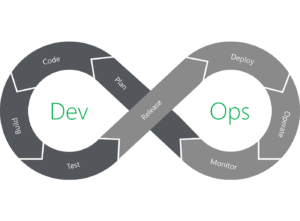26/04/2023
By Imran M

By Imran M
As experienced DevOps professionals, we understand the importance of DevOps infrastructure in driving successful software development. By harmonizing the roles of development and operations, we pave the way for seamless collaboration, streamlined workflows and faster time to market. In this deep dive article, we will explore the three essential pillars of modern DevOps: infrastructure, automation and monitoring and discuss the benefits of adopting these practices in your organization.
The integration of DevOps infrastructure, automation and monitoring is essential for organizations seeking to achieve success in the modern software development landscape. By investing in the right tools, technologies and practices, you can streamline workflows, improve collaboration and deliver high-quality software faster and more reliably. It’s important to continue learning, adapting and evolving our practices to meet the ever-changing demands of the industry. By embracing a culture of collaboration, continuous improvement and innovation, we can ensure that our DevOps practices remain at the cutting edge of software development.
The backbone of any successful DevOps practice is its infrastructure. DevOps infrastructure encompasses the tools, technologies and platforms that support the continuous integration, delivery and deployment of software. In this rapidly evolving landscape, choosing the right components and architecting a flexible, scalable and secure environment is essential.
The rise of cloud computing has transformed DevOps infrastructure, making it more accessible and cost-effective than ever before. Cloud-based DevOps infrastructure offers several advantages, such as scalability, flexibility and on-demand resources, enabling organizations to optimize their infrastructure based on their specific needs.
Containerization and microservices have become integral to modern DevOps infrastructure. By breaking down monolithic applications into smaller, manageable components, containerization and microservices enable more efficient deployment, scaling and management of applications. Tools like Docker and Kubernetes have become industry standards, helping teams manage and orchestrate containers seamlessly.
Automation is at the heart of DevOps, removing manual processes and human intervention wherever possible. By automating repetitive tasks, DevOps teams can focus on what matters most: delivering high-quality software faster and more efficiently. Automation also minimizes human error and enhances consistency across the development lifecycle.
CI/CD pipelines are crucial components of DevOps infrastructure, providing a seamless, automated process for building, testing and deploying software. CI/CD pipelines help developers catch issues earlier in the development process, reducing the time and effort needed to fix bugs and ensuring that the software is always production-ready.
Infrastructure as Code (IaC) is a key automation practice in DevOps, enabling teams to manage and provision their infrastructure using code. By treating infrastructure as code, DevOps teams can version control, test and collaborate on infrastructure changes, ensuring that environments are consistent, reproducible and easily maintainable.
Monitoring is a vital aspect of DevOps infrastructure, providing visibility into the performance, security and reliability of applications and infrastructure components. By monitoring systems and applications, DevOps teams can detect and resolve issues before they impact end-users, ensuring that the software delivers the expected user experience.
Application Performance Monitoring (APM) is an essential tool in DevOps, helping teams measure and optimize the performance of their applications. APM solutions provide real-time insights into application behaviour, enabling teams to identify and troubleshoot performance bottlenecks and optimize application performance.
As DevOps professionals, we must ensure that our software is secure and compliant with industry standards and regulations. Security monitoring and compliance tools help teams identify vulnerabilities and potential security risks, enabling them to proactively protect their applications and infrastructure.
Beyond the technical aspects of DevOps infrastructure, automation and monitoring, it is crucial to adopt a DevOps mindset and culture within your organization. This entails fostering collaboration, open communication and continuous learning among development and operations teams. By breaking down traditional silos, DevOps teams can work together more effectively, enabling faster, more reliable software delivery.
One of the core principles of DevOps is the establishment of feedback loops, which allow teams to continuously learn and improve their processes, practices and tools. By incorporating monitoring data and user feedback into the development process, DevOps teams can identify areas for improvement, iterate on their solutions and ensure that their software meets the evolving needs of their users.
Measuring the success of your DevOps infrastructure, automation and monitoring efforts is crucial for continuous improvement. Key metrics to track include deployment frequency, lead time for changes, change failure rate and mean time to recovery (MTTR). By monitoring these metrics, you can identify areas for improvement and optimize your DevOps practices over time.